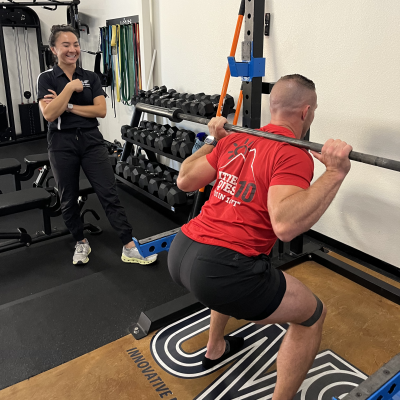Hip Pain
Are you tired of only sleeping on one side at night?
What we do for people with hip pain in as little as one visit
- Feel confident walking and squatting again
- Find and fix the real root cause
- Skip the steroid shots & pain pills


It’s been a real pleasuring working with the folks at Auto-ness. I highly recommend Dr. Grayson. He helped me through a hip injury and within a couple sessions I was pain free. I really liked how he focused on long term prevention and spent the time to educate me on proper exercise form and muscle engagement.
– Jeffrey Hegarty

Is Hip Pain Disrupting Your Ability to Lift Weights, Run, Jump, Squat, Climb Stairs, Get Up From a Low Seat, Sleep, or Carry Out Your Normal Work or Home Duties?
Does this resonate with you?
- You anticipated the pain would subside in a few days or weeks, but it persists?
- You attempted remedies like heating pads, ice, and home TENS units, but they provided no relief?
- Massages offered temporary relief, but the pain returned shortly afterward?
- A doctor prescribed injections or pills based on imaging, yet the relief was short-lived?
- Past attempts at physical therapy proved ineffective?
- You considered avoiding activities that trigger pain, thinking you can endure it?
We’re Here to Help You Discover Long-Term Solutions!
Typical Hip Conditions We Address:
- Arthritis
- Labral Tears
- Joint Instability
- Hamstring Strains
- Femoroacetabular Impingement
- Hip Flexor Tendinopathy
- Iliotibial Band (IT Band) Syndrome
- Pre/Post-Op Total Hip Replacement
Common Causes:
- Impaired Mechanics: stiffness in the joint or decreased muscle flexibility leading to reduced range of motion; weakness and muscle imbalance; impaired posture
- Injury: sudden impact or load to the tissue
- Chronic Compensations: a prior injury or fear of future injury leading to avoidance of activity in specific muscle groups, causing overuse of other tissues simultaneously
Auto-Ness Physical Therapy Approach:
- Break the pain cycle through education, manual therapy, and increased tissue mobility.
- Enhance joint, muscle, and nerve mechanics during daily tasks and exercise/sport-specific activities.
- Strengthen tissues to improve overall strength, power, and endurance, ensuring preparedness for all desired demands without fear of reinjury.
Hip-Specific Treatments:
- Correct Low Back and Pelvis Posture
- Enhance Fluid Exchange/Nutrition to the Joint (specific manual techniques to open the joint space)
- Boost Gluteal and Hip Rotator Muscle Group Strength for Stability
- Enhance Tissue Mobility through Massage, Instrument-Assisted Mobilization, Cupping, Dry Needling, and Stretching
- Reduce Nerve Sensitivity (numbness, tingling, leg pain) through Specific Nerve Exercises
- Progress Plyometric and Functional Activities (jumping, running, squatting, climbing)
Key Points to Understand:
- Tissues Heal: The body is designed to repair itself, but sometimes it needs assistance to transition from the inflammatory to the recovery phase.
- True Source of Pain: Imaging results might poorly correlate with pain. Visible damage on imaging may not cause pain, and pain can occur without visible findings – often due to nervous tissue oversensitivity.
- Soreness after Exercise: While not the goal, it's not always a cause for concern. True strength gains involve micro-damage, leading to tissue recovery and increased strength.
- Return to Activities: With proper education, mechanics, and progressive loading, a return to previous or desired activities is typically achievable.
